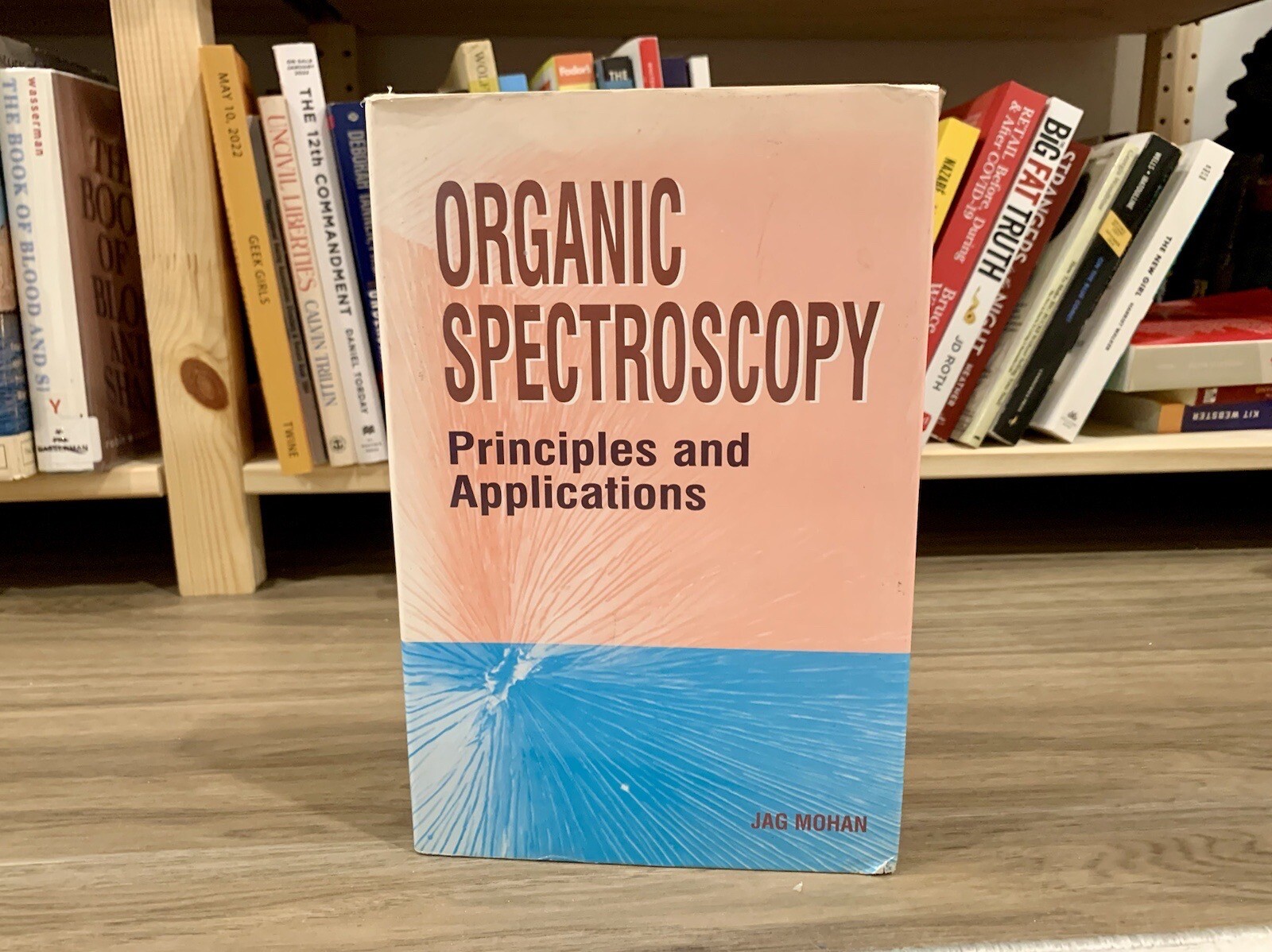Bild 1 von 12












Galerie
Bild 1 von 12












Ähnlichen Artikel verkaufen?
Organic Spectroscopy: Principles and Applications by Jag Mohan (2001, Hardcover)
US $75,00
Ca.CHF 60,44
(US $75,00 / Unit)
oder Preisvorschlag
Artikelzustand:
Oops! Looks like we're having trouble connecting to our server.
Refresh your browser window to try again.
Abholung:
Kostenlose Abholung in Englewood, New Jersey, USA.
Versand:
US $5,97 (ca. CHF 4,81) USPS Media MailTM.
Standort: Englewood, New Jersey, USA
Lieferung:
Lieferung zwischen Mi, 26. Nov und Mi, 3. Dez nach 94104 bei heutigem Zahlungseingang
Rücknahme:
30 Tage Rückgabe. Verkäufer zahlt Rückversand.
Zahlungen:
Sicher einkaufen
Info zum Artikel
Der Verkäufer ist für dieses Angebot verantwortlich.
eBay-Artikelnr.:266410208165
Artikelmerkmale
- Artikelzustand
- Country of Origin
- United States
- Series
- N/A
- Educational Level
- Adult & Further Education, Vocational School
- Personalized
- No
- Level
- Beginner, Intermediate, Advanced, Proficiency, Business, Technical
- Features
- 1st Edition, Dust Jacket, Illustrated
- MPN
- N/A
- California Prop 65 Warning
- N/A
- ISBN
- 9780849310072
Über dieses Produkt
Product Identifiers
Publisher
Narosa Publishing House
ISBN-10
0849310075
ISBN-13
9780849310072
eBay Product ID (ePID)
2537855
Product Key Features
Number of Pages
520 Pages
Publication Name
Organic Spectroscopy Principles and Applications : Principles and Applications
Language
English
Publication Year
2001
Subject
Chemistry / Organic, Chemistry / Industrial & Technical
Type
Textbook
Subject Area
Science
Format
Hardcover
Dimensions
Item Weight
35.5 Oz
Item Length
9 in
Item Width
6 in
Additional Product Features
Intended Audience
Scholarly & Professional
Table Of Content
General Introduction to Electromagnetic Spectrum and Molecular Spectroscopy Spectroscopy, Spectrometry and the Spectrum Nature of Electromagnetic Radiation and Electromagnetic Spectrum Absorption of Electromagnetic Radiation by Organic Molecules Types of Molecular Energies Types of Molecular Spectroscopy Infrared Spectroscopy Introduction Basic Theory and Instrumentation Important Useful Terms Concerning Infrared Spectroscopy Frequency of Vibration of a Diatomic Molecule and its Variation with Force Constant and Relative Masses of the Bonded Atoms Frequency Shifts by Change of Phase Solvents Spectral Features of Major Functional Groups and Interpretation of Infrared Spectra of Some Representative compounds Applications of Infrared Spectroscopy Spectral Problems and Solutions Ultraviolet Spectroscopy Basic Concepts and Instrumentation Factors Affecting the Position of UV Bands Characteristic Absorption of Organic Compounds Applications of UV Spectroscopy to Problems in Organic Chemistry Spectral Problems and Solutions Nuclear Magnetic Resonance Spectroscopy Introduction Spin-active Nuclei Behave as Spinning Nuclear Magnets Orientation of Spinning Nuclear Magnets in a Uniform Magnetic Field and Energy Description in NMR Phenomenon Phenomenon of Energy Absorption (Resonance) and Relaxation Continuous Wave (CW) NMR Spectrometer Chemical Shift, Chemical Shift Parameters and Internal Standards Factors Affecting the Chemical Shifts Equivalence and Non-equivalence of Photons Electron Coupled Spin-Spin Splitting Theory Types of Spin-Spin Couplings and Factors Affecting the Coupling Constants Interpretation of NMR Spectra of Some Representative Compounds Techniques for Simplification of Spectra FT:NMR Spectroscopy Applications of Nuclear Magnetic Resonance Spectroscopy Carbon-13 NMR Spectroscopy Two-Dimensional NMR Spectral Problems and Solutions Mass Spectrometry Introduction Basic Theory Instrumentation - The Mass Spectrometer Important Useful Terms Concerning Mass Spectrometry General Modes of Fragmentation Characteristic Features and Fragmentation Patterns of Various Classes of Compounds Chromatography-Mass Spectrometry Negative Ion Mass Spectrometry Some Important Applications of Mass Spectrometry Spectral Problems and Solutions Optical Rotary Dispersion and Circular Dichroism Introduction Circular Birefringence and Circular Dichroism Optical Rotatory Dispersion (ORD) The Axial Haloketone Rule and Octant Rule Applications of Octant Rule Appendix A: Fourier Transform Infrared Spectroscopy Introduction Instrumentation (Michelson Interferometer) Index
Synopsis
Rapid developments in spectroscopic techniques during the last two decades have revolutionized the approach to organic structure determination. Advanced topics in spectroscopy pertaining to infrared (IR), ultraviolet (UV), nuclear magnetic resonance (NMR), and mass spectroscopy (MS) are increasingly being introduced at the postgraduate level. Students majoring in organic chemistry have long been handicapped by the lack of availability of a suitable textbook covering the various aspects of organic spectroscopy. In order to succeed in graduate courses as well as in research, it is essential that students have a solid understanding of these techniques to elucidate and confirm the structure of organic molecules. Written primarily to stimulate the interest of students in spectroscopy and familiarize them with latest developments in the field, the book begins with a general introduction to electromagnetic radiation and molecular spectroscopy. In addition to the usual topics on IR, UV, NMR, and mass spectrometry, it includes substantial material on the major methods routinely used by organic chemists, such as FT-IR, FT-NMR, 13C-NMR, 2D-NMR, GC/MS, FAB/MS, and tandem and negative ion mass spectrometry. Finally, it gives a detailed account of Optical Rotatory Dispersion (ORD) and Circular Dichroism (CD). With numerous worked examples and problems that give ample insight into the topic concerned, Organic Spectroscopy: Principles and Applications will aid in the interpretation of molecular spectra and be of great value to graduate and postgraduate students.
Artikelbeschreibung des Verkäufers
Info zu diesem Verkäufer
Callahan Books
100% positive Bewertungen•3.8 Tsd. Artikel verkauft
Angemeldet als privater VerkäuferDaher finden verbraucherschützende Vorschriften, die sich aus dem EU-Verbraucherrecht ergeben, keine Anwendung. Der eBay-Käuferschutz gilt dennoch für die meisten Käufe.
Verkäuferbewertungen (1'499)
- 1***1 (944)- Bewertung vom Käufer.Letzter MonatBestätigter KaufSuper ⭐️ Seller!! Fast shipping and prompt delivery. Packaging was well-done and reliable. Book is in excellent condition exactly as described and pictured. The price was fair and accurate. Very happy with this purchase. Thank you!!
- m***g (125)- Bewertung vom Käufer.Letzter MonatBestätigter KaufShipped fast in a sturdy package, as described, for a great price!
- b***h (664)- Bewertung vom Käufer.Letzte 6 MonateBestätigter KaufBook in great condition as described, careful packaging, and fast shipping! A+ seller!!

